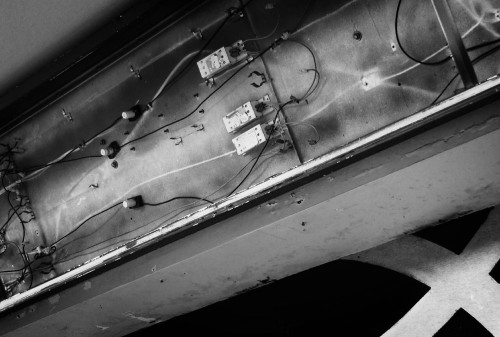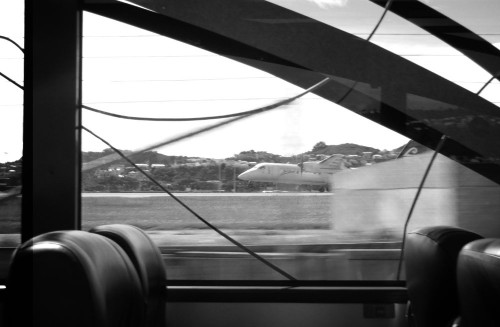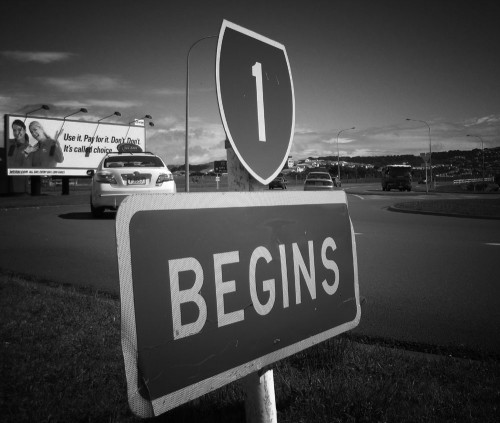Notional Significance: Flyer
Before reaching the starting point of the journey, I need to take a preliminary journey, from something resembling the heart of the city to the start of the highway: the airport. That in itself tells us something about just where cities fit into the whole “National Significance” agenda. A city is never an end in itself, just a portal to elsewhere.
So I begin in Manners St, waiting for the Airport Flyer. The streets themselves are in flux, the populace wary (though sometimes not wary enough: look both ways). The signs are gone — TIME ZONE — leaving the wiring exposed to the bright Sunday light.
The Flyer is on time. These buses aspire to higher echelons of transport: it’s not just the name and branding, but the leather seats, the aircon, the GPS display and canned “next stop” voice that all speak of something sleeker and more international than the clapped-out parochialism that the word “bus” still evokes. Arrivals and departures: you’re already focused on your destination. HAMILTON CANCELLED. Locals betray themselves by tagging on.
The Golden Mile route, and its stories, are well-rehearsed: the Battle(s) of Manners St, pigeons and pa, Courtenay Place’s evolution from swamp to terminus to brewers’ goldmine (RTDs and R&B for the B&T crowd, segregated heritage pubs for the lucrative babyboomer rugbyhead market). Past Queen Victoria, sequestered on a grassy island, no longer the magnet for Bolsheviks that she was in her original Queen’s Wharf home, then weaving up the flank of her eponymous mountain. We enter a notorious venue for games of pedestrian/car chicken (that in the daytime doubles as a bus tunnel).
The Eastern suburbs keep the Flyer down to earth, grounding its cosmopolitan pretensions in everyday hyperlocal reality. Bungalows, churches, exploding chip shops, YOUR LOCAL POINT. Through Hataitai, Kilbirnie, Rongotai, via the increasingly familiar post-industrial narrative of Tirangi Rd (warehouse to Warehouse; factory to retail ghetto), then Cook Strait bursts into view before us. Lyall Bay is dead flat, and dead empty: even our famously optimistic surfers are elsewhere.
The road turns south again, and the land becomes nothing but infrastructure. We rattle hard between runway and riprap, a light turboprop lifts gently into the wide blue sky, and the breakwaters have nothing to break. The bus slides beneath the runway, past shamanic abstractions (more Malevich than Lascaux, the minimalist cave-art of a tribe in a hurry) to the great S-bend of Moa Pt. Pipes slither across battered hillsides, the final passages of the city’s alimentary canal. The infamous anus of Wellington, at long last rigorously sterilised (bioreactors, ultraviolet irradiation), though the locals still mutter of intermittent miasmas: those in the know blame fatty deposits and occasional seawater enemas.
Just around the corner, Peter Kundycki’s sculpture “Doo doos” pokes fun, a scatological cairn marking the hopeful end of municipal shitfights. Also out of sight from the bus, and in fact unreadable to anyone except real flyers, is an even larger Kundycki piece, “Ko te Matau a Maui”. Why just stack concrete riprap in rows, awaiting their turn in the Strait, when you can have them arranged in curls and koru? From the air, it’s somewhere between Smithson and Nazca, opportunistic land art entwined with faux archaeology.
The airport is clean, efficient and well-mannered — no frazzled commuter grind, no jet-lagged intercontinental drift — and all quite disappointingly Mild at Heart. It’s still early, so I aim to emulate one of Sinclair’s good honest greasy-spoon fry-ups to kick off the trek, but with the exception of some unidentifiable deep-fried gunk, it’s mostly Lambton Quay-level quasi-healthy sandwich fare. I eventually secure something satisfactorily bacony, plus some coffee which is just good enough for Wellington but just bad enough for an airport, and take a seat by the giant runway window.
My hopes of immersing myself in the ceaseless flow and resonant placelessness of an international airport have been long since dashed, because it’s a Sunday morning and because, well, it’s Wellington. I catch a glimpse of the infamous new international terminal: The Rocks are fault-shattered and austere from this angle, bewilderingly anti-contextual yet craggily impressive, and utterly, resoundingly unpumpkinlike. Without scale cues, they seem more like a distant mountain range than a nearby building. They’re the only thing that disrupts your sense of place: the rest of the terminal focuses you out towards the Lyall Bay landscape, won’t let you forget where you are. The bus felt more global and rootless than this.
I leave the terminal, into a dark and taxi-ridden undercroft, but it’s been lamely de-Ballardised with cheery acid-bright corporate colour schemes. Then it’s out into the chirpy sunlight, airport functionalism on one side and golf-course on the other. Ath’s copper nikau strike a note of surrealism, hastily transplanted from Civic Square to form a squatly-proportioned attempt at a gateway. It’s not as psychically disruptive as the relocation of Temple Bar, but disconcerting nonetheless. There’s the briefest stretch of bijoux edgelands (barbed wire, fuel tankers, billboards, disappearing footpaths) and then a green roundabout: the start of the real journey; the beginning of National Significance; the dot at the bottom of the highway’s island-long exclamation mark. A sign: “1 BEGINS”.




As a former (brief) Wellingtonian, this made me long for another visit. Fantastic writing!
You do indeed write like a dream Mr Rune, a hazy mid-summer memory. Keep it up like that for another 400 postings and you’ll have a novel on your hands.